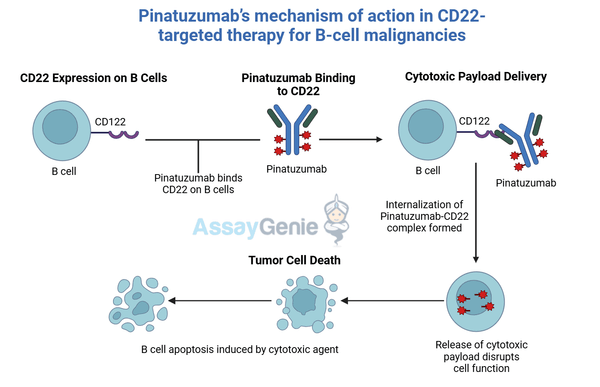Pinatuzumab: Advancing Cancer Research and Therapeutics
Pinatuzumab vedotin is an antibody-drug conjugate (ADC) targeting CD22, a cell surface marker highly expressed on malignant B cells. It delivers a potent cytotoxic agent directly to CD22-positive cells, making it a promising treatment for aggressive B-cell malignancies such as non-Hodgkin lymphoma (NHL) and diffuse large B-cell lymphoma (DLBCL). The biosimilar offers a cost-effective alternative, broadening access to CD22-targeted therapies.
This article explores the mechanism of action, clinical applications, and benefits of Pinatuzumab biosimilar in oncology.
1. Understanding CD22 and Its Role in B-Cell Malignancies
2. Pinatuzumab Biosimilar: A Cost-Effective Solution
Features of the Biosimilar
The Pinatuzumab biosimilar replicates the safety, efficacy, and quality of the original ADC while being more affordable.
3. Mechanism of Action
Step | Details |
|---|---|
CD22 Binding | |
ADC Internalization | The antibody-drug complex is internalized into the tumor cell. |
MMAF Release | The cytotoxic payload monomethyl auristatin F (MMAF) is released, disrupting microtubule assembly. |
Tumor Cell Death | MMAE induces apoptosis, selectively destroying CD22-positive cells. |
4. Clinical Applications
B-Cell Non-Hodgkin Lymphoma (NHL)
Diffuse Large B-Cell Lymphoma (DLBCL)
- Effective in patients with relapsed or refractory DLBCL.
- Demonstrates efficacy in combination with standard chemotherapy regimens.
Follicular Lymphoma (FL)
- Provides a targeted treatment option for relapsed or refractory FL cases.
Emerging Applications
Chronic Lymphocytic Leukemia (CLL)
- Investigated for potential use in CD22-positive CLL subsets.
Other CD22-Positive Malignancies
- Potential utility in other aggressive B-cell cancers, such as mantle cell lymphoma (MCL).
5. Benefits of Pinatuzumab Biosimilar
Precision Targeting
Delivers a potent cytotoxic payload specifically to CD22-positive cells, sparing healthy tissues.
Cost-Effective Access
The biosimilar reduces treatment costs, enabling wider access to advanced ADC therapies.
Combination Potential
Demonstrates synergistic effects when combined with chemotherapy or immune checkpoint inhibitors.
6. Challenges and Considerations
Adverse Effects
- Peripheral Neuropathy: A common side effect of MMAE that requires monitoring and dose adjustments.
- Hematologic Toxicity: Includes neutropenia and thrombocytopenia, manageable with supportive care.
Resistance Development
- Tumors may downregulate CD22 expression or develop alternative survival pathways. Combination strategies can help address resistance.
7. Comparison: Pinatuzumab vs. Biosimilar
Feature | Pinatuzumab Vedotin | Biosimilar |
|---|---|---|
Target | ||
Mechanism | ADC delivering MMAF to induce apoptosis. | ADC delivering MMAF to induce apoptosis. |
Indications | NHL, DLBCL, and CD22-positive malignancies. | NHL, DLBCL, and CD22-positive malignancies. |
Efficacy | Proven in clinical trials. | Equivalent in preclinical and clinical studies. |
Cost | High | Reduced, improving accessibility. |
8. Future Directions
Expanded Indications
- Investigating efficacy in pediatric B-cell malignancies.
- Exploring applications in autoimmune diseases involving pathogenic B cells.
Combination Strategies
- Checkpoint Inhibitors: Enhancing efficacy with anti-PD-1/PD-L1 therapies.
- CAR-T Cells: Potential synergy with CD22-directed CAR-T therapies for relapsed or refractory cases.
9. Summary Table
Aspect | Details |
|---|---|
Target | |
Primary Use | Treating NHL, DLBCL, and other CD22-positive malignancies. |
Mechanism of Action | ADC delivering MMAF to induce apoptosis in BCMA-positive cells. |
Biosimilar Benefits | Affordable, accessible, and clinically equivalent to Pinatuzumab Vedotin. |
Conclusion
The Pinatuzumab biosimilar represents a significant advancement in the treatment of CD22-positive B-cell malignancies. By combining tumor-specific targeting with a potent cytotoxic payload, it offers a precision approach to tackling aggressive cancers. Its cost-effective nature broadens access to advanced therapies, improving outcomes for patients worldwide.
References
- Kahl, B.S., et al., 2019. Targeting CD22 in relapsed/refractory B-cell malignancies with Pinatuzumab vedotin. Blood Advances, 3(12), pp.1812-1820.
- ClinicalTrials.gov, 2023. Studies on Pinatuzumab Vedotin and biosimilar therapies. Available at www.clinicaltrials.gov.
- European Medicines Agency (EMA), 2023. Guidelines for ADC biosimilar development. Available at www.ema.europa.eu.
- Salles, G., et al., 2020. Advances in CD22-targeted therapies for B-cell lymphomas. The Lancet Oncology, 21(8), pp.1022-1032.
- Ansell, S.M., et al., 2021. ADCs in lymphoma: The role of Pinatuzumab vedotin. Journal of Hematology & Oncology, 14(1), pp.1-10.
Recent Posts
-
Tigatuzumab Biosimilar: Harnessing DR5 for Targeted Cancer Therapy
Tigatuzumab is a monoclonal antibody targeting death receptor 5 (DR5), a member of the …17th Dec 2025 -
Enavatuzumab: Revolutionizing Cancer Research Through Novel Therapeutics
Enavatuzumab is a monoclonal antibody targeting TWEAK receptor (TWEAKR, also known as F …14th Jan 2025 -
Alemtuzumab: Mechanism, Applications, and Biosimilar Advancements
Alemtuzumab is a monoclonal antibody targeting CD52, a glycoprotein highly expressed on …13th Jan 2025




